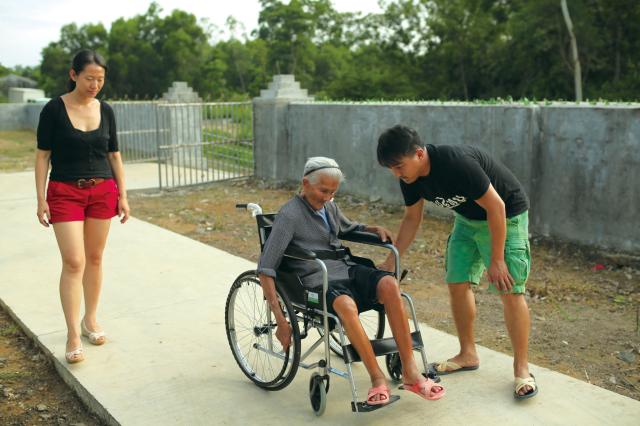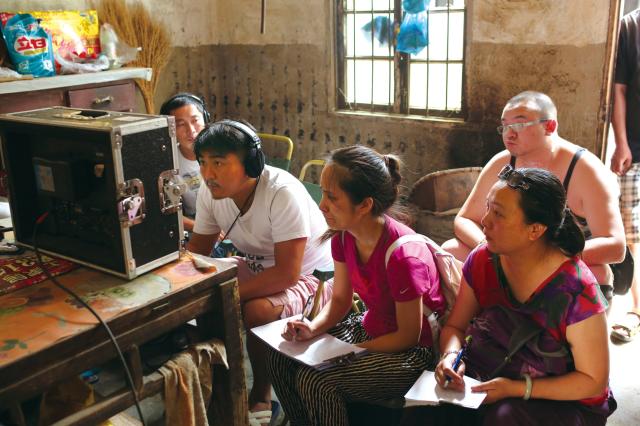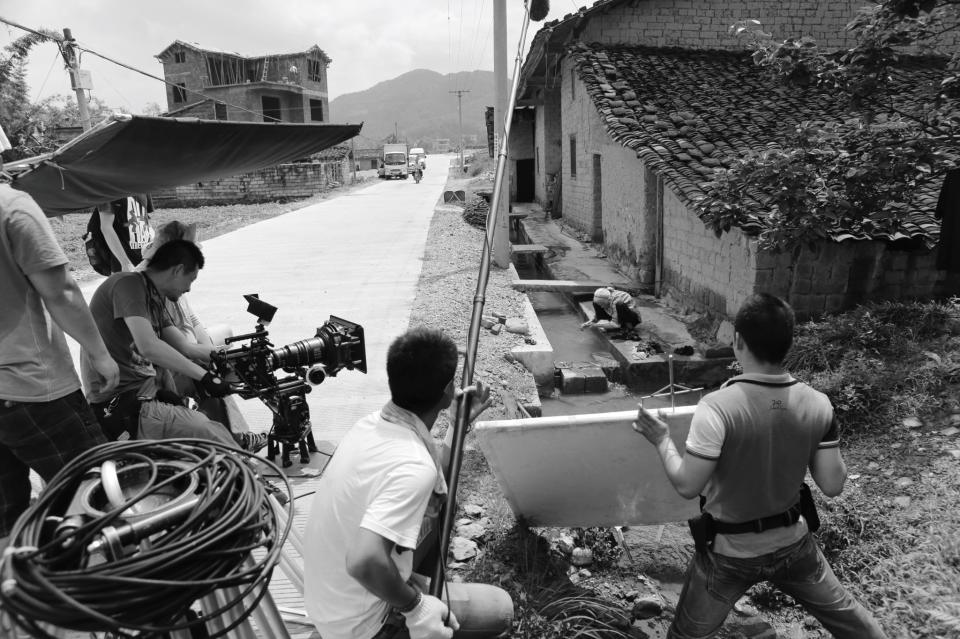With China’s last surviving comfort women passing away one by one, the most tangible link to a traumatic episode of wartime history is fading. Now, a young director is looking at how these women are living today, and offers a unique window into how different people process unspeakable experiences
During World War II, Chinese historians have estimated, over 200,000 women on the Chinese mainland were forced into sexual slavery by the Japanese army. The trauma experienced by these so-called “comfort women” remains a scar on the national psyche that refuses to heal.
While thousands were tortured to death, the few surviving comfort women who escaped the brutality of Japan’s military brothels found themselves living with unimaginable mental and physical pain. Many were left infertile or physically disabled by their experiences. As of April 2016, the number of known surviving Chinese comfort women fell to 22.
After spending years seeking out and visiting many of these remarkable survivors, Guo Ke, a young film director, cut together two documentaries on the subject, which he named Thirty Two and Twenty Two.
Guo, 36, uses the “present tense” to confront this historical issue, faithfully recording the daily lives of this unique group of survivors in a more sober, controlled and less sentimental way than is customary in Chinese documentaries concerning events related to the Second Sino-Japanese War (1937-1945).
Guo refers to his subjects as a group of people who have “buried their nightmares” in order to live as normally as possible. What they need, he claims, is not pity or sympathy but understanding and respect.
Survivors Guo told NewsChina that, from the very beginning, his approach to his films’ subject matter had a touch of utilitarianism.
Born in 1980 in Chengdu, the capital of Sichuan Province, Guo, like many young men in China’s blossoming entertainment industry, harbored dreams of becoming an actor. At 18, he joined an actor training program run by a Hong Kong director, and, after graduation, worked various production jobs, including wardrobe assistant, gaffer and production assistant. He started working as an assistant director in 2002, and in the following decade he participated in the making of dozens of TV dramas.
But Guo longed for the chance to make a film of his own. In 2012, he stumbled across the story of former comfort woman Wei Shaolan and her half-Japanese son, and realized he had found his inspiration.
In 1944, then 20-year-old Wei, a member of the Yao ethnic group from a village in Lipu County, Guangxi Zhuang Autonomous Region, was captured along with her infant daughter by Japanese soldiers, and forced into sexual slavery in a local “comfort station.” After three months of torture, Wei managed to escape her captors.
But, soon after she reunited with her husband, she found she was pregnant with a Japanese soldier’s child. Her neighbors and fellow villagers, upon discovering her condition, treated her with contempt, and she became an outcast.
Luo Shanxue, Wei’s half-Japanese son, has lived his whole life with the shame and stigma of his Japanese blood. Unable to find a woman willing to marry him, Luo, now in his 70s, still lives at home with his mother.
The more he learned of this family’s story, the more Guo felt that the “dramatic conflict” in their tale “had the potential to become a good film.” “I felt an incredibly strong sense of responsibility to document this story,” Guo told our reporter. “I can make commercial movies my whole life. But this subject is so transient that, if I didn’t seize my chance right away, it might have been lost forever.” In 2012, with the help of Su Zhiliang, director of the Chinese Comfort Women Issue Research Center, Guo visited Wei Shaolan and her son in person.
After spending a month with Wei and visiting other survivors in the following years, Guo was moved to discover that, behind the label of “comfort women,” his subjects were ordinary people searching for a simple life. As long as no one inquired about her wartime experiences, Wei was an optimistic, cheerful woman who, despite being in her 90s, loved to laugh and sing folk songs.
Guo’s crew of almost 30 shot many hours of footage documenting Wei’s daily life, which he later edited into a 43-minute documentary, Thirty Two, named for the officially recorded number of surviving comfort women in China at the time.
One year after the film was completed, 10 of those women were dead.
Gripped by a new sense of urgency, Guo vowed to make a featurelength documentary to faithfully record the lives of China’s last surviving comfort women, a project he named Twenty Two. From January to July of 2014, Guo’s team visited 20 comfort women living in five provinces – Heilongjiang, Shanxi, Hubei, Guangxi and Hainan.
“I wanted to use the best techniques to immortalize them,” he told NewsChina.
Old Wounds
Over the decades, numerous journalists, volunteers, directors and academics had already approached Guo’s subjects, each hoping to break the wall of silence which typically surrounds comfort women reluctant to publicize their miseries. Their prying, some of these women would tell Guo, opened up old wounds.
Long Qing, a volunteer member of Guo’s crew, recalled one incident which occurred while shooting footage of Li Ailian, a former comfort woman in Shanxi Province.
“If the Japanese returned, I would rather die!” Li yelled at her TV while watching a live broadcast commemorating the 77th anniversary of the Marco Polo Bridge Incident, usually cited as the beginning of the Japanese occupation of China proper during World War II.
Long told NewsChina she instinctively leaned in to touch the elderly woman’s cheek with her own to comfort her, a tender moment which Guo captured on camera.
During the fourth day of shooting, Li happily hummed a tune she said her village choir had sung after hearing of the Japanese retreat, but her jovial mood quickly evaporated when assistant director Liang Qiao abruptly asked: “What did the Japanese do to you when you were captured?” Long recalled how Li fell silent, her face turning ghastly pale. It was not until the sixth day of the shoot that she revealed some of her experiences.
She recounted: “That man’s surname was Yanagi, he was about 40 years old. He asked me to marry him. I was 18 and already married.
I said no. He locked me up for three days, starved me, forced me to swallow raw scallions on an empty stomach.” Li began to weep as she recalled her torture, adding she had suffered stomach problems for the rest of her life.
Li’s willingness to relate her own experiences, Guo told our reporter, was relatively rare among the interviews he conducted with the survivors. Other women were only willing to tell him what the Japanese had done to other victims, refusing to elaborate on their own trauma. Guo also discovered a gulf of openness between the women who later traveled to Japan to give evidence as material witnesses at war crimes hearings, and those who had remained behind in China.
Those who had not appeared in court to directly accuse their torturers, Guo continued, typically chose more obscure and euphemistic expressions to tell their stories. Phrases like “he said he wanted me to marry him,” “he asked me to follow him,” or “he humiliated me,” all references to rape, allowed victims to avoid explicitly using a term which, in rural China in particular, remains taboo and loaded with shame and stigma.
Wei Shaolan, however, a woman who once joined a team of lawyers and volunteers who traveled to Japan to file a lawsuit against the Japanese government, had no qualms about describing what happened to her as “rape.” A Korean woman surnamed Park, who fled to China in early adolescence and was captured and raped by Japanese soldiers, declined to discuss her experiences with Guo. During their interview, Guo discovered that Park could, however, remember the courteous Japanese phrases that comfort women were ordered to use with their clients.
Guo later identified the comfort station where Park had been enslaved.
In the final cut of Twenty Two, shots of Park speaking Japanese are juxtaposed with images of the ruined brothel.

Wheelchair-bound Lin Ailan, now deceased, pictured near her home in Lingao County, Hainan Province, June 2014

Director Guo Ke (second from the left) does postproduction work on Twenty Two
Final Cut
Twenty Two contains no historical material, no timeline, no thirdparty interpretation and no off-screen voice-over. All it shows are the lives of China’s surviving comfort women. Incorporating other source material, Guo feels, would cause “secondary trauma” to his subjects.
In the words of the film’s Taiwanese consulting editor Liao Chingsong, Guo is “using the present tense to talk about historical events.” Guo himself struggles to say for sure if his unorthodox approach will move his audience. Guo’s technique, Liao told our reporter, was to keep the women center stage, and not use flashy special effects or attention-grabbing newsreel footage. Instead, Liao continued, he would “watch them with a pair of eyes full of emotion, love and care, but without pity or sympathy, hold them in that last gaze, and keep them there, unfaded.” In the film, under Guo’s “gaze,” his subjects share photos of their youth, pleasantly chat with crew members, play mahjong with neighbors, feed stray cats and quietly sit on their stoops, singing and taking in the sun. They have tried to bury the pain and horror of their lost youth and struggle to live ordinary lives.
In one scene, Park is shown singing the Korean folk songs “Arirang” and “The Balloon-flower Ballad.” Guo told our reporter he feels his subjects preferred to express themselves in song, weaving happiness, sorrow, nostalgia and hope into their favorite melodies.
The 112-minute final cut of Twenty Two had its world premiere at the Busan International Film Festival last October. On April 29, the film won the Committee Special Recommendation Award at the 23rd Beijing Student Film Festival.
Making the two documentaries has completely changed Guo’s life.
He described both shoots as a “soul searching journey,” adding that “the making of these two works allowed me to be truly and completely myself.” For the past two years, Guo has spent two weeks in January visiting China’s surviving comfort women, a pilgrimage he has pledged to maintain until his final interviewee passes away. The young filmmaker sees this as his duty, a form of atonement for these women’s often heavy-handed past treatment at the hands of documentarians, himself included.
This past January, when Guo and Long Qing arrived in Hainan Province to revisit former comfort woman Lin Ailan, they were told she had died less than three weeks previously, on December 23, at the age of 90. Despite later serving at age 14 in an anti-Japanese guerilla detachment of the Red Army, Lin never managed to escape the stigma of being a former comfort woman. She never married, and spent her twilight years alone and struggling with illness in a nursing home, only able to move around by supporting herself on a pink plastic chair.
According to local tradition, a woman with no male offspring cannot have a tombstone. Lin was instead buried with her medal that commemorated the 60th anniversary of the defeat of Japan. With the help of the Chinese Comfort Women Research Center, Long Qing was able to convince the local government to provide a tombstone for Lin in time for the Tomb Sweeping Festival.

 Old Version
Old Version

